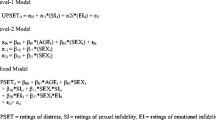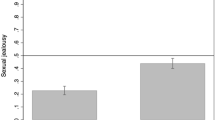Abstract
Past research has suggested that men are more upset by imagined sexual than emotional infidelity, and women are more upset by imagined emotional infidelity than sexual infidelity. However, experience with infidelity, methodology, and age and gender of the sample may help to explain inconsistent results. Two hundred ninety-four English-speaking undergraduate students and 325 non-college adults in a large mid-Atlantic urban area of the U.S. completed forced-choice or continuous-scale anonymous questionnaires regarding jealousy over a mate’s hypothetical infidelity. Chi-square and MANOVA analyses replicated previous findings of the expected gender difference in all hypothetical forced-choice scenarios. However, results for those participants who reported experience with actual infidelity demonstrated little support for the traditional evolutionary model, as there were no gender differences in which aspect of hypothetical infidelity was reported to be more distressing, and no gender differences at the college level in terms of which aspect of infidelity received the greatest focus. These findings, extrapolated from both undergraduates and adults and accounting for the impact of actual, primed memory of experience of infidelity on hypothetical jealousy scenarios, raise important questions about the validity of hypothetical scenarios of jealousy as proxies for real reactions to actual infidelity. The results of the present study suggest that the lack of a consistent, replicable gender difference across the lifespan may be explained by two related factors: age and actual experience with infidelity.
Similar content being viewed by others
References
Becker, D. V., Sagarin, B. J., Guadagno, R. E., Millevoi, A., & Nicastle, L. D. (2004). When the sexes need not differ: Emotional responses to the sexual and emotional aspects of infidelity. Personal Relationships, 11, 529–538. doi:10.1111/j.1475-6811.2004.00096.x.
Berman, M. I., & Frazier, P. A. (2005). Relationship power and betrayal experience as predictors of reactions to infidelity. Personality and Social Psychology Bulletin, 31, 1617–1627. doi:10.1177/0146167205277209.
Brase, G. L., Caprar, D. V., & Voracek, M. (2004). Sex differences in responses to relationship threats in England and Romania. Journal of Personal and Social Relationships, 21, 763–764. doi:10.1177/0265407504047836.
Buss, D. M. (2000). The dangerous passion: Why jealousy is as necessary as love and sex. New York: Free.
Buss, D. M., Larsen, R. J., Westen, D., & Semmelroth, J. (1992). Sex differences in jealousy: Evolution, physiology, and psychology. Psychological Science, 3, 251–255. doi:10.1111/j.1467-9280.1992.tb00038.x.
Buss, D. M., Larsen, R. J., & Westen, D. (1996). Sex differences in jealousy: Not gone, not forgotten, and not explained by alternative hypotheses. Psychological Science, 7, 373–375. doi:10.1111/j.1467-9280.1996.tb00392.x.
Buss, D. M., Shackelford, T. K., Kirkpatrick, L. A., Choe, J. C., Lim, H. K., Hasegawa, M., Hasegawa, T., & Bennett, K. (1999). Jealousy and the nature of beliefs about infidelity: Tests of competing hypotheses about sex differences in the United States, Korea, and Japan. Personal Relationships, 6, 121–150. doi:10.1111/j.1475-6811.1999.tb00215.x.
Buunk, B., Angleitner, A., Oubaid, V., & Buss, D. M. (1996). Sex differences in jealousy in evolutionary and cultural perspective: Tests from the Netherlands, Germany, and the United States. Psychological Science, 7, 359–363. doi:10.1111/j.1467-9280.1996.tb00389.x.
Dantzker, M. L., & Eisenman, R. (2005). Sexual attitudes among Hispanic students at a border university: Gender differences and failure to support Buss’s jealousy theory. Journal of Evolutionary Psychology, 26, 71–80.
de Souza, A. A. L., Verderane, M. P., Taira, J. T., & Otta, E. (2006). Emotional and sexual jealousy as a function of sex and sexual orientation in a Brazilian sample. Psychological Reports, 98, 529–535. doi:10.2466/PR0.98.2.529-535.
DeSteno, D. A., & Salovey, P. (1996). Evolutionary origins of sex differences in jealousy? Questioning the “fitness” of the model. Psychological Science, 7, 367–372. doi:10.1111/j.1467-9280.1996.tb00391.x.
DeSteno, D. A., Bartlett, M. Y., Braverman, J., & Salovey, P. (2002). Sex differences in jealousy: Evolutionary mechanism or artifact of measurement? Journal of Personality and Social Psychology, 83, 1103–1116. doi:10.1037/0022-3514.83.5.1103.
Edlund, J. E., Heider, J. D., Scherer, C. R., Farc, M., & Sagarin, B. J. (2006). Sex differences in jealousy in response to actual infidelity. Evolutionary Psychology, 4, 462–470. Retrieved from http://www.epjournal.net/filestore/ep04462470.pdf.
Eisenman, R., & Dantzker, M. L. (2006). Gender and ethnic differences in sexual attitudes at a Hispanic-serving university. The Journal of General Psychology, 133, 153–162. doi:10.3200/GENP.133.2.153-162.
Fernandez, A. M., Vera-Villarroel, P., Sierra, J. C., & Zubeidat, I. (2007). Distress in response to emotional and sexual infidelity: Evidence of evolved gender differences in Spanish students. The Journal of Psychology, 14, 17–24. doi:10.3200/JRLP.141.1.17-24.
Garcia, J. R., & Reiber, C. (2008). Hook-up behavior: A biopsychosocial perspective. Journal of Social, Evolutionary, and Cultural Psychology, 2, 192–208. Retrieved from http://www.jsecjournal.com/articles/volume2/issue4/NEEPSgarciareiber.pdf.
Geary, D. C., DeSoto, M. C., Hoard, M. K., Sheldon, M. S., & Cooper, M. L. (2001). Estrogens and relationship jealousy. Human Nature, 12, 299–320. doi:10.1007/s12110-001-1001-2.
Green, M. C., & Sabini, J. (2006). Gender, socioeconomic status, age and jealousy: Emotional responses to infidelity in a national sample. Emotion, 6, 330–334. doi:10.1037/1528-3542.6.2.330.
Grice, J. W., & Seely, E. (2000). The evolution of sex differences in jealousy: Failure to replicate previous results. Journal of Research in Personality, 34, 348–356. doi:10.1006/jrpe.2000.2284.
Harris, C. R. (2000). Psychophysiological responses to imagined infidelity: The specific innate modular view of jealousy reconsidered. Journal of Personality and Social Psychology, 78, 1082–1091. doi:10.1037/0022-3514.78.6.1082.
Harris, C. R. (2002). Sexual and romantic jealousy in heterosexual and homosexual adults. Psychological Science, 13, 7–12. doi:10.1111/1467-9280.00402.
Harris, C. R. (2003a). Factors associated with jealousy over real and imagined infidelity: An examination of the social-cognitive and evolutionary psychology perspectives. Psychology of Women Quarterly, 27, 319–329. doi:10.1111/1471-6402.00112.
Harris, C. R. (2003b). A review of sex differences in sexual jealousy, including self-report data, psychophysiological responses, interpersonal violence, and morbid jealousy. Personality and Social Psychology Review, 7, 102–128. doi:10.1207/S15327957PSPR0702_102-128.
Harris, C. R., & Christenfeld, N. (1996). Gender, jealousy, and reason. Psychological Science, 7, 364–366. doi:10.1111/j.1467-9280.1996.tb00390.x.
Hofhansl, A., Voracek, M., & Vitouch, O. (2004). Sex differences in jealousy: A meta-analytical reconsideration. Paper presented at the 16th Annual Meeting of the Human Behavior and Evolution Society, Berlin, Germany.
Hupka, R. B., & Bank, A. L. (1996). Sex differences in jealousy: Evolution or social construction? Cross-Cultural Research, 30, 24–59. doi:10.1177/106939719603000102.
Kimeldorf, M. B. (2009). Reactions to infidelity: Individual, gender, and situational predictors of relationship outcome and forgiveness. Dissertation Abstracts International: Section B. Sciences and Engineering, 69(7-B), 4427.
Levy, K. N., & Kelly, K. M. (2010). Sex differences in jealousy: A contribution from attachment theory. Psychological Science, 21, 166–173. doi:10.1177/0956797609357708.
Mathes, E. W. (2005). Relationship between short-term sexual strategies and sexual jealousy. Psychological Reports, 96, 29–35. doi:10.2466/pr0.96.1.29-35.
Mathews, T. J., & Hamilton, B. E. (2002). Mean age of mother, 1970–2000. National vital statistics reports, 51. Hyattsville: National Center for Health Statistics. Retrieved from http://www.cdc.gov/nchs/data/databriefs/db21.pdf.
Miller, S. L., & Maner, J. K. (2009). Sex differences in response to sexual versus emotional infidelity: The role of individual differences. Personality and Individual Differences, 46, 287–291. doi:10.1016/j.paid.2008.10.013.
Murphy, M. M., Vallacher, R. R., Shackelford, T. K., Bjorklund, D. F., & Yunger, J. L. (2006). Relationship experience as a predictor of romantic jealousy. Personality and Individual Differences, 40, 761–769. doi:10.1016/j.paid.2005.09.004.
Penke, L., & Asendorpf, J. B. (2008). Evidence for conditional sex differences in emotional but not in sexual jealousy at the automatic level of cognitive processing. European Journal of Personality, 22, 3–30. doi:10.1002/per.654.
Pietrzak, R. H., Laird, J. D., Stevens, D. A., & Thompson, N. S. (2002). Sex differences in human jealousy: A coordinated study of forced-choice, continuous rating-scale, and physiological responses on the same subjects. Evolution and Human Behavior, 23, 83–94. doi:10.1016/S1090-5138(01)00078-2.
Sabini, J., & Green, M. C. (2004). Emotional responses to sexual and emotional infidelity: Constants and differences across genders, samples, and methods. Personality and Social Psychology Bulletin, 30, 1375–1388. doi:10.1177/0146167204264012.
Sagarin, B. J. (2005). Reconsidering evolved sex differences in jealousy: Comment on Harris (2003). Personality and Social Psychology Review, 9, 62–75. doi:10.1207/s15327957pspr0901_5.
Sagarin, B. J., & Guadagno, R. E. (2004). Sex differences in the context of extreme jealousy. Personal Relationships, 11, 319–328. doi:10.1111/j.1475-6811.2004.00085.x.
Sagarin, B. J., Becker, D. V., Guadagno, R. E., Nicastle, L. D., & Millevoi, A. (2003). Sex differences (and similarities) in jealousy: The moderating influence of infidelity experience and sexual orientation of the infidelity. Evolution and Human Behavior, 24, 17–23. doi:10.1016/S1090-5138(02)00106-X.
Schutzwohl, A. (2007). Decision strategies in continuous ratings of jealousy feelings elicited by sexual and emotional infidelity. Evolutionary Psychology, 5, 815–828. Retrieved from http://www.epjournal.net/filestore/ep05815828.pdf.
Shackelford, T. K., Buss, D. M., & Bennett, K. (2002). Forgiveness or breakup: Sex differences in responses to a partner’s infidelity. Cognition and Emotion, 16, 299–307. doi:10.1080/02699930143000202.
Sheets, V. L., & Wolfe, M. D. (2001). Sexual jealousy in heterosexuals, lesbians, and gays. Sex Roles, 44, 255–276. doi:10.1023/A:1010996631863.
Takahashi, H., Matsuura, M., Yahata, N., Koeda, M., Suhara, T., & Okubo, Y. (2006). Men and women show distinct brain activations during imagery of sexual and emotional infidelity. NeuroImage, 32, 1299–1307. doi:10.1016/j.neuroimage.2006.05.049.
Trivers, R. (1972). Parental investment and sexual selection. In B. Campbell (Ed.), Sexual selection and the descent of man: 1871–1971 (pp. 136–179). Chicago: Aldine.
Voracek, M. (2001). Marital status as a candidate moderator variable of male-female differences in sexual jealousy: The need for representative population samples. Psychological Reports, 88, 553–566. doi:10.2466/PR0.88.2.553-566.
Wade, T. J., & Fowler, K. (2006). Sex differences in response to sexual and emotional infidelity: Considerations of rival attractiveness and financial status. Journal of Cultural and Evolutionary Psychology, 4, 37–50. doi:10.1556/JCEP.4.2006.1.3.
Ward, J., & Voracek, M. (2004). Evolutionary and social cognitive explanations of sex differences in romantic jealousy. Australian Journal of Psychology, 56, 165–171. doi:10.1080/00049530412331283381.
Wiederman, M. W., & Allgeier, E. R. (1993). Gender differences in sexual jealousy: Adaptionist or social learning explanation? Ethology and Sociobiology, 14, 115–140. doi:10.1016/0162-3095(93)90011-6.
Wiederman, M. W., & Kendall, E. (1999). Evolution, sex, and jealousy: Investigation with a sample from Sweden. Evolution and Human Behavior, 20, 121–128. doi:10.1016/S1090-5138(98)00046-4.
Author information
Authors and Affiliations
Corresponding author
Rights and permissions
About this article
Cite this article
Varga, C.M., Gee, C.B. & Munro, G. The Effects of Sample Characteristics and Experience with Infidelity on Romantic Jealousy. Sex Roles 65, 854–866 (2011). https://doi.org/10.1007/s11199-011-0048-8
Published:
Issue Date:
DOI: https://doi.org/10.1007/s11199-011-0048-8




